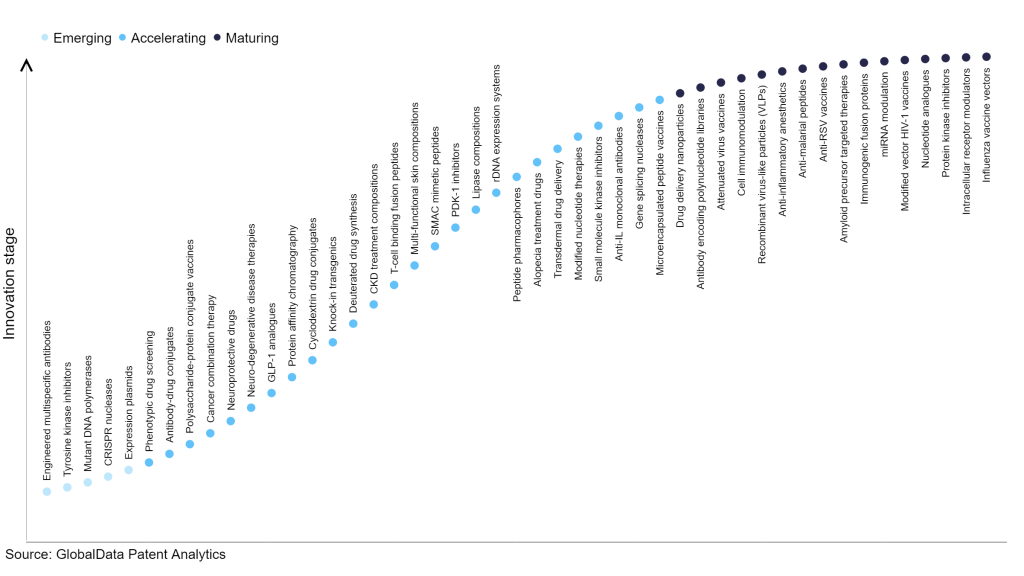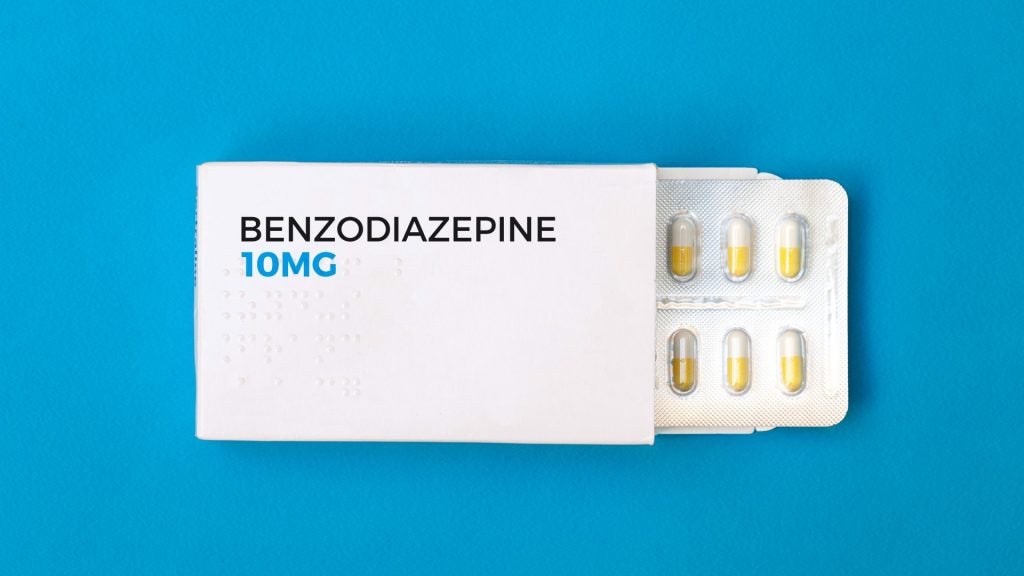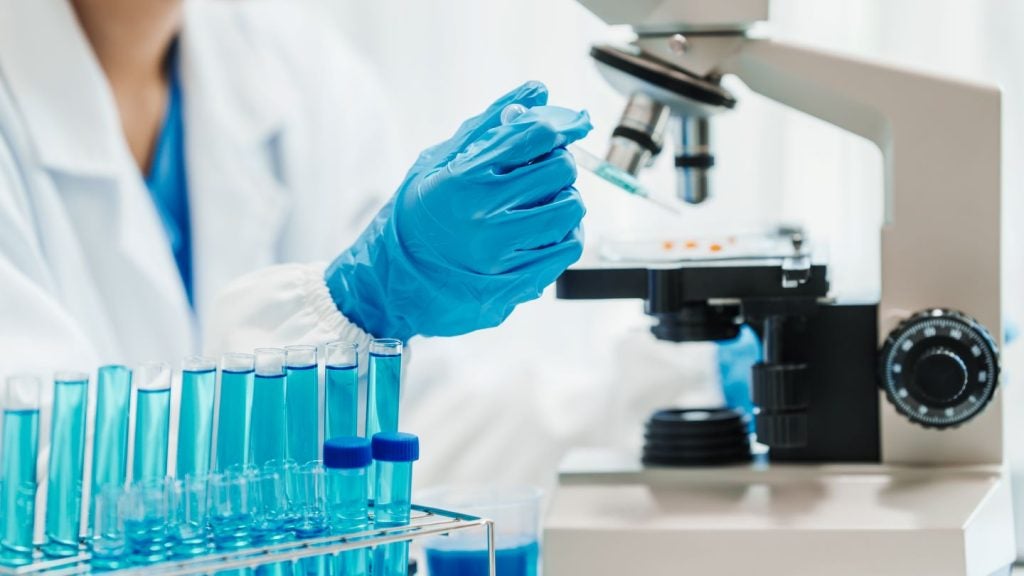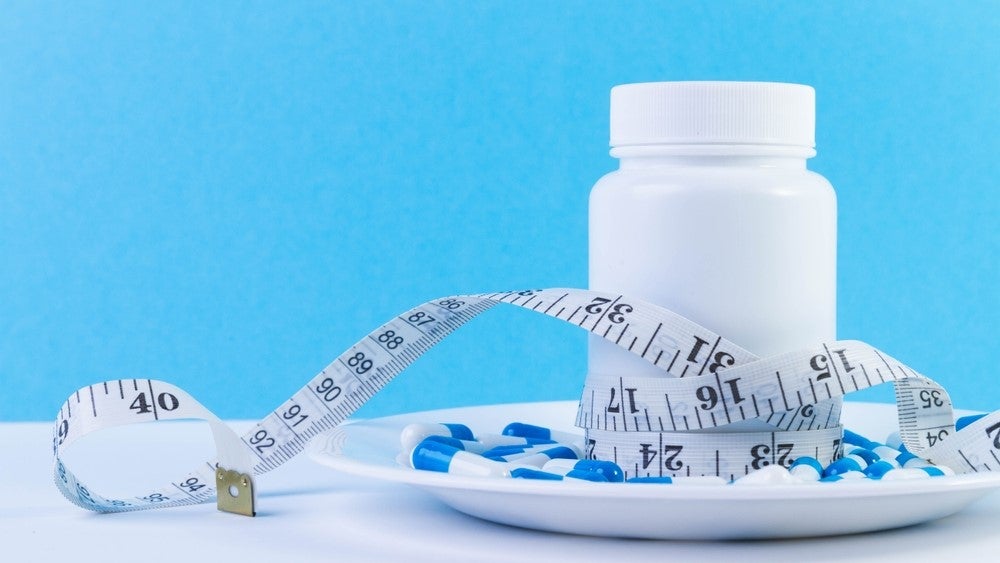The pharmaceutical industry continues to be a hotbed of patent innovation. Activity is driven by the evolution of new treatment paradigms, and the gravity of unmet needs, as well as the growing importance of technologies such as pharmacogenomics, digital therapeutics, and artificial intelligence. In the last three years alone, there have been over 787,000 patents filed and granted in the pharmaceutical industry, according to GlobalData’s report on Innovation in pharma: drug delivery nanoparticles. Buy the report here.
However, not all innovations are equal and nor do they follow a constant upward trend. Instead, their evolution takes the form of an S-shaped curve that reflects their typical lifecycle from early emergence to accelerating adoption, before finally stabilizing and reaching maturity.
Identifying where a particular innovation is on this journey, especially those that are in the emerging and accelerating stages, is essential for understanding their current level of adoption and the likely future trajectory and impact they will have.
80+ innovations will shape the pharmaceutical industry
According to GlobalData’s Technology Foresights, which plots the S-curve for the pharmaceutical industry using innovation intensity models built on over 668,000 patents, there are 80+ innovation areas that will shape the future of the industry.
Within the emerging innovation stage, engineered multispecific antibodies, tyrosine kinase inhibitors, and mutant DNA polymerases are disruptive technologies that are in the early stages of application and should be tracked closely. Phenotypic drug screening, antibody-drug conjugates, and polysaccharide-protein conjugate vaccines are some of the accelerating innovation areas, where adoption has been steadily increasing. Among maturing innovation areas are drug delivery nanoparticles and antibody encoding polynucleotide libraries, which are now well established in the industry.
Innovation S-curve for the pharmaceutical industry

Nanoparticles for drug delivery is a key innovation in pharmaceutical
A nanoparticle is a small particle ranging in size from 1 to 100 nanometers. Nanoparticles are used as novel drug delivery systems to deliver drugs to specific tissues and to provide controlled release therapy. With the targeted and sustained delivery of drugs, patients are more likely to comply with less frequent dosing and experience less drug toxicity. Metal nanoparticles, liposomes, nanocrystals, and polymeric nanoparticles are the most common types of nanoparticles. Transporting insoluble drugs into the blood through stable colloidal systems and controlled drug release is one of the major advantages of this.
GlobalData’s analysis also uncovers the companies at the forefront of each innovation area and assesses the potential reach and impact of their patenting activity across different applications and geographies. According to GlobalData, there are 70+ companies, spanning technology vendors, established pharmaceutical companies, and up-and-coming start-ups engaged in the development and application of nanoparticles for drug delivery.
Key players in drug delivery nanoparticles – a disruptive innovation in the pharmaceutical industry
‘Application diversity’ measures the number of applications identified for each patent. It broadly splits companies into either ‘niche’ or ‘diversified’ innovators.
‘Geographic reach’ refers to the number of countries each patent is registered in. It reflects the breadth of geographic application intended, ranging from ‘global’ to ‘local’.
Patent volumes related to drug delivery nanoparticles
| Company | Total patents (2010 - 2022) | Premium intelligence on the world's largest companies |
| Bristol-Myers Squibb | 97 | Unlock Company Profile |
| Ipsen | 84 | Unlock Company Profile |
| Insmed | 40 | Unlock Company Profile |
| Laboratory Skin Care | 37 | Unlock Company Profile |
| Marinus Pharmaceuticals | 37 | Unlock Company Profile |
| Yuhan | 33 | Unlock Company Profile |
| SN BioScience | 28 | Unlock Company Profile |
| Midatech Pharma | 22 | Unlock Company Profile |
| Leading Edge Innovations | 21 | Unlock Company Profile |
| Intezyne | 20 | Unlock Company Profile |
| SignPath Pharma | 19 | Unlock Company Profile |
| Ecole Polytechnique Federale de Lausanne | 17 | Unlock Company Profile |
| Phosphorex | 17 | Unlock Company Profile |
| NuVessl | 17 | Unlock Company Profile |
| Merrimack Pharmaceuticals | 16 | Unlock Company Profile |
| NanoValent Pharmaceuticals | 14 | Unlock Company Profile |
| Trendmed | 14 | Unlock Company Profile |
| GreenMark Biomedical | 13 | Unlock Company Profile |
| Aquestive Therapeutics | 13 | Unlock Company Profile |
| Children's Hospital Los Angeles | 13 | Unlock Company Profile |
| Samyang | 12 | Unlock Company Profile |
| Aphios | 12 | Unlock Company Profile |
| Biophile | 12 | Unlock Company Profile |
| UK Research and Innovation | 12 | Unlock Company Profile |
| Centre National de la Recherche Scientifique | 11 | Unlock Company Profile |
| MAA Laboratories | 11 | Unlock Company Profile |
| Pfizer | 11 | Unlock Company Profile |
| Op Nano | 11 | Unlock Company Profile |
| RAG-Stiftung | 9 | Unlock Company Profile |
| HERMES Biosciences | 8 | Unlock Company Profile |
| Nitto Denko | 8 | Unlock Company Profile |
| Uni-President China | 8 | Unlock Company Profile |
| Abbott Laboratories | 8 | Unlock Company Profile |
| Laila Pharmaceuticals | 8 | Unlock Company Profile |
| Nanobiotix | 8 | Unlock Company Profile |
| Msrx US | 7 | Unlock Company Profile |
| Crystalplex | 7 | Unlock Company Profile |
| MonoSol Rx | 7 | Unlock Company Profile |
| PT Soho Global Health | 6 | Unlock Company Profile |
| Kimia Zist Parsian (Kzp) | 6 | Unlock Company Profile |
| IP Group | 5 | Unlock Company Profile |
| Well Shield | 5 | Unlock Company Profile |
| Avadel Pharmaceuticals | 5 | Unlock Company Profile |
| Transave | 5 | Unlock Company Profile |
| Malvern Cosmeceutics | 5 | Unlock Company Profile |
| Akina | 5 | Unlock Company Profile |
| Axcelon Biopolymers | 4 | Unlock Company Profile |
| Empire Technologies | 4 | Unlock Company Profile |
| Zydus Lifesciences | 4 | Unlock Company Profile |
| Mireca Medicines | 4 | Unlock Company Profile |
Source: GlobalData Patent Analytics
Bristol-Myers Squibb is the leading patent filer in drug delivery nanoparticles. BMS has a market cap of $125.28bn and is primarily focused on oncology, hematology, cardiovascular, immunology, and fibrotic therapeutic projects. In 2005, the FDA approved Bristol-Myers Squibb's Abraxane, a PX albumin-bound nanoparticle formulation with 130nm particles, for treating metastatic breast cancer. Ipsen SA and Insmed Inc are the other key patent filers in nanoparticles for drug delivery.
In terms of application diversity, Leading Edge Innovations is the top company, followed by Laila Pharmaceuticals and Abbott Laboratories. By means of geographic reach, Insmed holds the top position. Laboratory Skin Care and South Korean pharmaceutical company Yuhan are in second and third positions, respectively.
To further understand the key themes and technologies disrupting the pharmaceutical industry, access GlobalData’s latest thematic research report on Pharmaceutical.
Premium Insights
From

The gold standard of business intelligence.
Blending expert knowledge with cutting-edge technology, GlobalData’s unrivalled proprietary data will enable you to decode what’s happening in your market. You can make better informed decisions and gain a future-proof advantage over your competitors.







